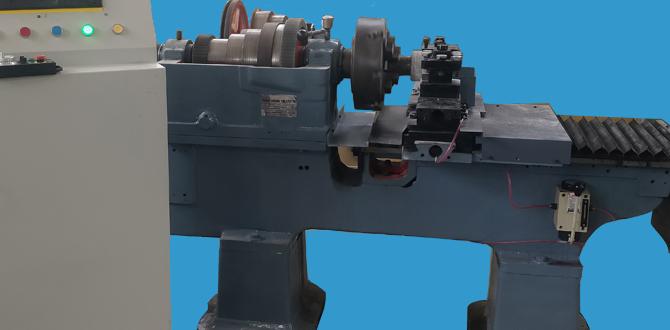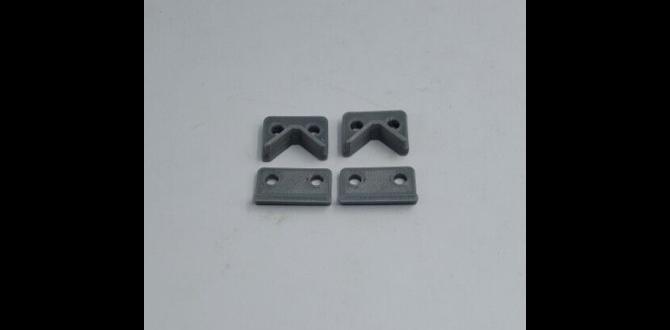Roughing end mills remove material quickly, while finishing end mills create smooth, precise surfaces. Understanding the differences helps you choose the right tool for faster, better results in your machining projects. This guide will show you how!
Hey there, fellow makers! Daniel Bates from Lathe Hub here. Ever found yourself staring at a workpiece, ready to mill, but unsure which end mill to grab? You’ve got this big chunk of metal or wood, and you want to shape it efficiently without ruining the finish. It’s a common puzzle for anyone diving into machining. The good news? It’s not as complicated as it seems! We’re going to break down the difference between roughing end mills and finishing end mills so you can tackle your projects with confidence. Get ready to learn the secrets to faster material removal and beautiful, smooth finishes.
Roughing End Mill vs. Finishing End Mill: What’s the Big Deal?
So, you’re in the workshop, maybe working on some carbon steel or a solid piece of hardwood, and you need to shape it. You’ll likely reach for an end mill. But not all end mills are created equal! Think of them like a sculptor’s tools: some are for quickly chipping away big chunks, and others are for the fine details. That’s essentially the difference between a roughing end mill and a finishing end mill.
Using the wrong tool can lead to slow progress, rough surfaces, and even damage to your workpiece or the cutting tool itself. Knowing which one to pick is a foundational skill that will save you time, effort, and frustration. Let’s get into the specifics of what makes each one unique.
Meet the Roughing End Mill: The Material Remover
A roughing end mill is your go-to tool when you need to remove a lot of material, fast. Its main job is to get you close to your final shape quickly. It’s not about creating a beautiful surface finish; it’s about efficiency in the early stages of machining.
Key Features of Roughing End Mills:
- Aggressive Cutting Action: These tools are designed to take deep cuts and high feed rates. They eat through material like nobody’s business.
- Specialized Geometry: Roughing end mills often have special flute forms that break up chips into smaller, manageable pieces. This prevents them from clogging the flutes and overheating the tool.
- Uneven Tooth Spacing (Chipbreakers): Many roughing mills feature uneven spacing between their cutting teeth. This helps to disrupt the cutting forces, reducing vibration and allowing for deeper cuts.
- Not for Precision Finishes: Because of their aggressive nature, roughing mills will leave a somewhat coarse surface finish. Following up with a finishing tool is usually necessary for a smooth result.
When to Use a Roughing End Mill:
- Bulk Material Removal: When you need to clear out a large pocket, reduce the overall size of a part, or simply get rid of excess material quickly.
- Initial Shaping: Before any precise features or smooth surfaces are required, a roughing mill gets you most of the “rough” work done.
- Working with Tough Materials: Their sturdy design and aggressive cutting action can be beneficial when machining harder metals like carbon steel, although proper speeds and feeds are still crucial. For instance, understanding the machinability ratings of steels can help inform your choices. The Sandvik Coromant resource on steel machinability is a great place to learn more about this.
Pros and Cons of Roughing End Mills
Let’s look at the upsides and downsides:
| Pros | Cons |
|---|---|
| Significantly faster material removal. | Leaves a rough surface finish. |
| Reduces machining time considerably. | Not suitable for achieving tight tolerances or smooth finishes. |
| Can handle deeper axial and radial cuts. | Can generate more heat and vibration due to aggressive cutting. |
| Less prone to tool chatter when removing large amounts of material. | May require more power from your machine. |
Meet the Finishing End Mill: The Precision Artist
If the roughing end mill is the bulk remover, the finishing end mill is the artist. Its job is to create smooth, accurate surfaces and to achieve the final dimensions of your part. These tools are all about precision and surface quality.
Key Features of Finishing End Mills:
- Smooth Cutting Action: Finishing mills are designed for light cuts and high speeds. They shear material cleanly, leaving a smooth surface.
- Sharp Edges and Fine Flutes: They typically have sharp, well-defined cutting edges and a higher number of flutes (often 4 or more) compared to roughing mills. More flutes mean they can spin faster for a given chip load, leading to a better finish.
- Even Tooth Spacing: Usually, finishing end mills have evenly spaced teeth. This contributes to a consistent, smooth cut.
- Designed for Accuracy: These mills are ideal for machining to final size and achieving tight tolerances.
When to Use a Finishing End Mill:
- Achieving Final Dimensions: Once you’re close to your target size from roughing, you switch to a finishing mill to get those exact measurements.
- Creating Smooth Surfaces: For parts that need to look good or have mating surfaces that need to slide smoothly, a finishing mill is essential.
- Machining Features: For pocketing, profiling, or contouring where a high-quality surface finish is required.
- Woodworking Applications: In woodworking, finishing end mills (often router bits with similar geometry) are used to create decorative edges, clean out dados, and achieve smooth joinery.
Pros and Cons of Finishing End Mills
Here’s a look at the advantages and disadvantages:
| Pros | Cons |
|---|---|
| Produces excellent surface finishes. | Removes material much slower than roughing mills. |
| Achieves high accuracy and tight tolerances. | Not designed for deep cuts or aggressive material removal. |
| Leaves a clean, precise edge. | More susceptible to chip jamming if used for heavy roughing. |
| Ideal for the final stages of machining. | Can wear out faster if pushed too hard. |
Roughing End Mill vs. Finishing End Mill: A Direct Comparison
Let’s put them side-by-side to highlight their key differences. This can be super helpful when you’re deciding which tool to reach for.
| Feature | Roughing End Mill | Finishing End Mill |
|---|---|---|
| Primary Goal | Fast Material Removal | Smooth Surface Finish & Accuracy |
| Cutting Action | Aggressive, Chunking | Shearing, Smooth |
| Flute Design | Chipbreakers, often uneven spacing | Sharp, fine flutes, often even spacing |
| Number of Flutes | Typically 2-3 | Typically 4+ |
| Cut Depth | Deep Axial & Radial Engagement | Shallow Axial & Radial Engagement |
| Surface Finish | Rough, Coarse | Smooth, Fine |
| Speed & Feed | Lower Spindle Speed, Higher Feed Rate | Higher Spindle Speed, Lower Feed Rate |
| Best Use Case | Bulk material removal, initial shaping | Final dimensions, precise features, smooth surfaces |
Choosing the Right End Mill for Your Project
The decision between a roughing and a finishing end mill, or even using both, depends on what you want to achieve. Here’s a simple way to think about it:
1. What’s Your Goal?
- If you need to carve out a big pocket quickly: Grab a roughing end mill.
- If you need to make a part fit perfectly or look super smooth: Use a finishing end mill for the final passes.
- If you’re doing both: Start with a roughing end mill to get close, then switch to a finishing end mill to dial in the final dimensions and surface.
2. Consider the Material
The material you’re working with plays a big role. For example, when working with carbon steel, a roughing end mill can help you remove material efficiently in the early stages. However, you’ll definitely need a finishing end mill for the final cuts to achieve the desired smoothness and accuracy. Different steels and alloys have varying hardness and chip-forming characteristics, which influence the best milling strategies. Understanding these properties is key to tool longevity and part quality. For a deeper dive into how materials affect your cuts, resources from organizations like the National Institute of Standards and Technology (NIST) Machining Database can offer valuable data on material properties and machining parameters.
3. Think About Your Machine and Setup
A more powerful machine can handle the aggressive cuts of a roughing end mill better. If you have a smaller hobbyist machine, you might need to be more conservative with your cuts, even with a roughing mill. Finishing mills are generally less demanding on the machine but require a stable setup for accuracy.
Example Workflow: Machining a Simple Pocket
Let’s walk through a common scenario: machining a simple square pocket in a block of aluminum.
- Step 1: Setup. Secure your workpiece firmly in your milling machine vise. Ensure it’s indicated squarely.
- Step 2: Initial Roughing. Choose a roughing end mill that’s slightly smaller than your desired pocket width. Set your machine to appropriate speeds and feeds for roughing aluminum (you’ll want a relatively fast feed rate and a moderate spindle speed).
- Step 3: Bulk Material Removal. Program or manually mill the pocket using your roughing end mill. Take cuts that are within the tool’s and machine’s capabilities. You’re aiming to remove most of the material quickly, leaving a bit of stock for the finishing pass (e.g., 0.010 to 0.020 inches or about 0.25 to 0.5 mm).
- Step 4: Tool Change. Once the bulk of the material is removed, change to a finishing end mill. This should be the exact size of your desired pocket or slightly larger if you just need a clean inner wall.
- Step 5: Finishing Pass. Set your machine for finishing (usually a higher spindle speed and a slower feed rate). Make a single, light pass around the pocket walls at your final depth. This pass will remove the remaining stock and leave a clean, smooth surface and precise dimensions.
- Step 6: Inspect. Carefully measure your pocket to ensure it meets your dimensional requirements and check the surface finish visually.
Specialty End Mills: Beyond the Basics
While roughing and finishing end mills are the most fundamental types, you’ll encounter others as you progress:
- Ball End Mills: Have a rounded tip, perfect for creating curved surfaces, contours, and 3D shapes.
- Corner Radius End Mills: Feature a small radius on the corners, which adds strength to the cutting edge and can create a slightly rounded internal corner on a pocket, reducing stress risers.
- Tapered End Mills: Have a conical shape, used for cutting tapered holes or features.
- Carbide vs. HSS: End mills also differ in material. High-Speed Steel (HSS) is more forgiving but cuts slower. Carbide is harder, cuts faster, and holds an edge longer, but is more brittle.
For a comprehensive overview of different tool types and their applications, you can explore resources like those from the Manufacturing USA website, which provides detailed descriptions of various cutting tools.
Safety First!
No matter which end mill you’re using, safety is paramount. Always:
- Wear safety glasses or a face shield.
- Secure your workpiece properly.
- Ensure the end mill is securely held in the collet or chuck.
- Use the correct speeds and feeds for the material and tool.
- Keep your hands and clothing away from moving parts.
- Be aware of chip evacuation, especially with roughing mills.
- Understand your machine’s capabilities and limitations.
Frequently Asked Questions (FAQ)
Q1: Can I use a roughing end mill for finishing?
A1: While you can take a very light finishing pass with a roughing end mill, it’s not recommended. The aggressive geometry will likely result in a poor surface finish, and you won’t achieve precise dimensions. It’s best to use a dedicated finishing end mill for those critical final passes.
Q2: How do I know how much stock to leave for the finishing pass?
A2: For most general machining, leaving 0.010 to 0.020 inches (0.25 to 0.5 mm) of stock is a good starting point. For very fine finishes or critical tolerances, you might leave less. Always refer to your project’s specific requirements.
Q3: What’s the difference between a two-flute and a four-flute end mill?
A3: Two-flute end mills are generally better for roughing and slotting because they have more space for chip evacuation, allowing for deeper cuts and higher feed rates. Four-flute end mills are typically used for finishing, as more flutes allow for a higher spindle speed for a given chip load, resulting in a smoother finish.
Q4: Does it matter if my end mill has coatings?
A4: Yes, especially for certain materials. Coatings like TiN (Titanium Nitride) or TiAlN (Titanium Aluminum Nitride) can increase hardness, reduce friction, and improve heat resistance, extending tool life and allowing for faster machining in materials like harder steels.
Q5: My roughing end mill is leaving a wavy finish. What am I doing wrong?
A5: This can happen with roughing mills. Ensure your machine’s spindle is in good condition with no runout. Also, proper speeds and feeds are crucial; sometimes, adjusting the feed rate slightly or ensuring you’re not taking too deep a radial cut can help. Uneven tooth spacing is designed to help, but it’s not always a perfect solution on its own.
Q6: Can I use the same end mill for both roughing and finishing?
A6: You can, but it’s not ideal for optimal results. A tool designed for roughing will compromise the finish, and a finishing tool will wear out quickly and be inefficient if used for heavy material removal. It’s best to have separate tools for each job and switch between them for the best outcome.
Conclusion
So there you have it! The distinction between roughing and finishing end mills is a vital concept for any aspiring machinist or maker. Roughing end mills are your workhorses, designed for rapid material removal to get you to your basic shape quickly. They’re aggressive, efficient, and built to eat through material. On the other hand, finishing end mills are your precision tools, crafted to deliver that perfectly smooth surface and exact final dimension. They’re delicate artists that require a lighter touch but yield spectacular results.
By understanding their unique geometries, designs, and purposes, you can confidently select the right tool for each stage of your machining project. This knowledge will not only speed up your work but also significantly improve the quality and accuracy of your finished parts. Remember to always prioritize safety, use the correct speeds and feeds for your material, and don’t be afraid to experiment (within safe limits!) to find what works best on your specific machine. Happy milling, and may your cuts be clean and your finishes be smooth!





